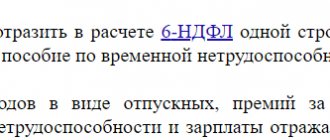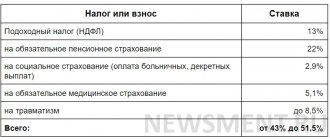Who can apply
The tax system is designed for agricultural producers . These may be considered:
- Organizations and entrepreneurs, satisfying the conditions:
- they produce, process (primary and subsequent) and sell agricultural products (if an organization does not independently produce agricultural products, but is only engaged in their processing and sale, then it cannot switch to the Unified Agricultural Tax);
- in the year preceding the transition to the unified agricultural tax, the share of income from the sale of such products in total income must be at least 70% .
- Organizations and entrepreneurs providing support services in the field of agriculture (according to OKVED). The share of income from the provision of these services must be at least 70% of total income. Agricultural auxiliary services include:
- in terms of crop production - preparing fields, sowing, cultivating, growing, spraying, pruning, harvesting, and so on;
- in the field of livestock farming - grazing, inspection, distillation, keeping farm animals and caring for them.
- Agricultural cooperatives These are processing, trading, supply, gardening, market gardening, livestock consumer cooperatives with a share of income from these types of activities of at least 70%.
- Fisheries subjects:
- city- and village-forming fisheries organizations;
- production cooperatives in the fisheries sector;
- fishing enterprises and individual entrepreneurs (special requirements are imposed on this category of agricultural producers).
Business entities cannot apply the Unified Agricultural Tax if they:
- produce excisable products;
- carry out activities related to organizing gambling;
- are state-owned, budgetary or autonomous institutions.
The list of products that, for the purpose of applying the Unified Agricultural Tax, are classified as agricultural, was approved by Decree of the Government of the Russian Federation of July 25, 2006 No. 458.
Who can be a payer of the Unified Agricultural Tax
A full description of taxpayers entitled to the Unified Agricultural Tax is given in Art. 346.2. Tax Code of the Russian Federation. They can only be:
- Organizations and individual entrepreneurs, as well as agricultural consumer cooperatives that produce, process and sell agricultural products. This condition must be considered comprehensively, that is, all these requirements must be taken into account. It’s just that processors and sellers of agricultural products do not have the right to the Unified Agricultural Tax.
- City-forming and village-forming Russian fishery organizations, provided that the number of workers in them, taking into account family members living with them, is at least 50% of the population of this locality. This also includes fishing cooperatives (collective farms). In this case, fishing must be carried out on fishing fleet vessels owned by right of ownership or on the basis of charter agreements.
- Organizations and individual entrepreneurs that provide services to agricultural producers in the field of crop and livestock production.
What replaces
In the following table we have listed which taxes are being replaced by the Unified Agricultural Tax for organizations and entrepreneurs.
Table 1. What taxes does the Unified Agricultural Tax replace?
| Tax | A comment |
| For organizations | |
| Corporate income tax | In addition to income tax on dividends and some other transactions |
| Organizational property tax | In terms of property that is used for the production and processing of agricultural products, as well as the provision of services to agricultural producers |
| For entrepreneurs | |
| Personal income tax (for yourself) | In relation to activities subject to Unified Agricultural Tax |
| Property tax for individuals | In terms of property that is used for the production and processing of agricultural products, as well as the provision of services to agricultural producers |
From 2019, entities on the Unified Agricultural Tax are VAT payers and will be able to deduct input tax.
Being exempt from the taxes indicated in the table, entities on the Unified Agricultural Tax continue to play the role of tax agents. In particular, they pay personal income tax for their employees.
Tax exemption
An organization that has switched to paying the Unified Agricultural Tax is exempt from paying:
- VAT (except for VAT on the import of goods and when carrying out operations under agreements of joint activities, trust management of property or concession agreements);
- income tax (except for income tax on dividends, interest on state (municipal) securities and on profits of controlled foreign companies);
- property tax.
All other taxes, fees and charges must be paid on a general basis. In particular, contributions for compulsory pension (social, medical) insurance (clause 1, part 1, article 5 of the Law of July 24, 2009 No. 212-FZ), contributions for insurance against accidents and occupational diseases (paragraph 7, art. 3 of the Law of July 24, 1998 No. 125-FZ), transport tax (Article 357 of the Tax Code of the Russian Federation), payment for environmental pollution (Resolution of the Government of the Russian Federation of August 28, 1992 No. 632).
This procedure is provided for in paragraph 3 of Article 346.1 of the Tax Code of the Russian Federation.
In addition, organizations that have switched to the unified agricultural tax perform the duties of tax agents:
- for VAT (Article 161 of the Tax Code of the Russian Federation);
- for personal income tax (clause 1 of article 226 of the Tax Code of the Russian Federation);
- for income tax (clauses 2, 3, Article 275, Article 310 of the Tax Code of the Russian Federation).
This is stated in paragraph 4 of Article 346.1 of the Tax Code of the Russian Federation.
How to go
The main criterion for the possibility of switching to the Unified Agricultural Tax is the classification of a subject as an agricultural producer with a share of income from this activity of at least 70% of the total income. No other conditions, including revenue volume or number of employees, have been established.
To switch to the unified agricultural tax, a notification is submitted to the tax authority at the location or place of residence. This must be done before December 31 of the year preceding the start of the regime. Newly registered entities can submit a notification of transition to the Unified Agricultural Tax within 30 days from the date of registration. If the notification is not submitted within the time limits established by law, the entity cannot apply the Unified Agricultural Tax.
If the subject submitted a notification and became a payer of the Unified Agricultural Tax, the following rules apply to it:
- He will not be able to abandon the regime, that is, switch to a different tax system, until the end of the year . To change the regime, you will need to submit a notification to the Federal Tax Service no later than January 15.
- If at the end of the year the subject ceases to meet the conditions allowing it to apply the unified agricultural tax, then it loses the right to this system from the beginning of the year in which this happened.
- A taxpayer who has lost the right to unified agricultural tax must independently inform the Federal Tax Service that he is switching to a different tax regime. This must be done within 15 days of the end of the tax period.
- It will be possible to return to the use of the unified agricultural tax no earlier than a year after the right to it was lost.
Start of application of the unified agricultural tax
Manufacturers are starting to use unified agricultural tax:
- from January 1 of the year following the year in which they achieved compliance with all the necessary criteria for applying this special regime and notified the tax authorities;
- from the moment of the start of commercial activity, if the notification of the beginning of the Unified Agricultural Tax is submitted within the time limits established by the Tax Code of the Russian Federation (for beginning agricultural producers).
IMPORTANT! If an agricultural producer forgot to notify the tax authorities about the transition (start of application) to the unified agricultural tax or did not manage to do this within the time limits established by the Tax Code of the Russian Federation, he is not considered a taxpayer of the unified agricultural tax.
Such “forgetfulness” results in the need to apply the previous taxation regime, without having the right to apply for the Unified Agricultural Tax until next year.
How to calculate tax
The object of taxation of the Unified Agricultural Tax is the difference between income and expenses . What exactly is included in income and expenses is defined in Article 346.5 of the Tax Code of the Russian Federation. Income is accounted for on a cash basis, that is, recognized on the day of receipt. Expenses - after actual payment. Income and expenses are summed up from the beginning of the year on an accrual basis.
reduce the tax base by its amount . The loss can be carried forward for 10 years.
When the tax base is calculated, a tax rate of 6% .
Paying tax
The tax period under the Unified Agricultural Tax is a calendar year, and the reporting period is a half-year. Based on the results of the six months, taxpayers must calculate the amount of the advance payment . The advance is paid within 25 days after the end of the reporting period, that is, until July 25 . At the end of the year, the total amount of the unified agricultural tax is calculated. It must be paid no later than March 31 of the year following the reporting year.
Declaration on Unified Agricultural Tax
Once a year, payers submit a declaration under the Unified Agricultural Tax to the Federal Tax Service at the place of registration of the organization or place of residence of the individual entrepreneur. The filing deadline is March 31 of the year following the reporting year. Upon termination of activity as an agricultural producer, the declaration is submitted by the entity no later than the 25th day of the following month.
The declaration form and the procedure for filling it out were approved by Federal Tax Service Order No. ММВ-7-3/ [email protected] (as amended by Federal Tax Service Order No. ММВ-7-3/ [email protected] ) . The report consists of a title page and 4 sections:
- Section 1 . The amount of advance payment under the Unified Agricultural Tax is indicated, as well as the amount of tax to be paid additionally or reduced, calculated at the end of the year.
- Section 2 . Tax calculation is provided.
- Section 2.1 . The amount of loss for previous periods is given.
- Section 3 . A report on the intended use of property received as part of charitable activities, targeted financing or targeted income. If the taxpayer did not receive such property, including cash, in the reporting year, then this section is not completed.
Title page
General filling rules
When filling out the Unified Agricultural Tax declaration, you should adhere to the following rules:
- All pages starting from the title page must be numbered.
- Each sheet must indicate the TIN and KPP.
- Each field contains one indicator. If it is not there, a dash is added.
- When filling out manually, you can use blue, black and purple ink. Only capital letters should be used.
- When filling out on a computer, Courier New font 16 - 18 points is used.
- All amounts are indicated in rubles, kopecks are discarded (up to 50 kopecks) or rounded to the full ruble (more than 50 kopecks).
- Corrections of errors in the declaration are not allowed.
- When printing, each page should be on a separate sheet.
- It is better not to staple documents.
Features of the declaration under the Unified Agricultural Tax
The following table summarizes the rules and features of filling out the report.
Table 2. Features of filling out sections of the Unified Agricultural Tax declaration
| Line / Column | What to indicate |
| Title page | |
| Correction number | When submitting for the first time - 0, when passing again - the serial number of the correction (1,2,3...) |
| Tax period (code) |
|
| Code of place of submission of the declaration |
|
| Number of pages |
|
| Information about the person who signed the declaration |
|
| Section 1 | |
| Lines 001, 003 | OKTMO code. If the code has not changed during the year, line 003 does not need to be filled in |
| Line 002 | Advance payment amount for half a year |
| Line 004 | Amount of Unified Agricultural Tax to be paid additionally. Positive difference between the final tax for the year and the advance payment. |
| Line 005 | The amount of unified agricultural tax is to be reduced. Negative difference between the final tax for the year and the advance payment. |
| Section 2 | |
| Line 010 | Income according to the Unified Agricultural Tax |
| Line 020 | Expense according to Unified Agricultural Tax |
| Line 030 | Positive difference between income and expenses. If the result is negative, put 0 |
| Line 040 | The amount of loss for previous years taken to reduce the base (not more than the amount of the tax base) |
| Line 045 | Unified agricultural tax rate (6%) |
| Line 050 | Amount of Unified Agricultural Tax. It is calculated as the difference between the tax base and the amount accepted for loss reduction, multiplied by the rate |
| Section 2.1 | |
| Line 010 | The total amount of losses for previous tax periods indicated in lines 020-110 |
| Lines 020-110 | Detailed losses by year |
| Line 120 | Amount of loss for the reporting year |
| Line 130 | The total amount of losses that can be carried forward to subsequent tax periods |
| Lines 140-230 | Details of line 130. Amounts of losses by year when they occurred |
| Section 3 | |
| Box 1 | Code of the type of receipts from Appendix No. 5 to the Procedure for filling out the declaration under the Unified Agricultural Tax |
| Column 2 | Date of receipt of target funds (TS); |
| Column 3 | Cost of CS (goods, property, works, services, funds); |
| Column 4 | The amount of CAs that were used for their intended purpose during the period |
| Box 5 | Date by which the CA must be used |
| Box 6 | The amount of CAs that have not expired |
| Column 7 | The amount of CAs that are not used or used for other purposes |







